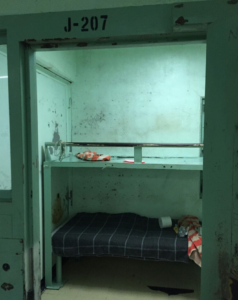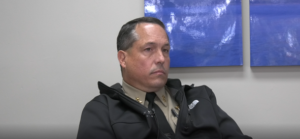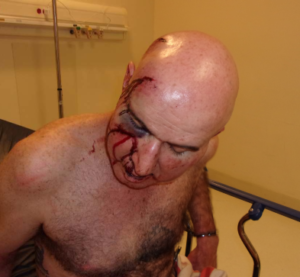PLG Reaches $225,000 Settlement in Police Brutality Case Against Monterey County Jail and Its Deputies
The attorneys at PLG have finalized the settlement of a police brutality case filed in 2018. The case was originally filed by the client without an attorney. The civil rights attorneys at the Piccuta Law Group were later retained and took over the case.
The case was filed in the United States District Court of California, Northern District. It was assigned case # 3:18-CV-04467 and entitled Dunham v. County of Monterey, Et Al. The case was before Magistrate Judge Alex G. Tse. A dismissal of the case was recently entered after the $225,000 in settlement funds were paid in full.
Details Surrounding the Police Excessive Force Case
The case arose from a jail beating at the hands of correctional officers. The client was a pre-trial detainee who was arrested but had not been convicted of any crime. While housed at Monterey County Jail, he experienced a medical emergency due to alcohol withdrawal. The Monterey County Jail is run by the Monterey County Sheriff’s Office and its deputies.

The client started hallucinating and sweating after he entered delirium tremens—a life threatening medical condition caused by alcohol withdrawal. Instead of summoning medical attention, multiple sheriff deputies decided they would perform a cell extraction. The deputies who performed the extraction claimed it was needed for the client’s safety. The deputies claimed the client was acting erratically. However, their only plan was to line up four deputies, rush into the cell, tase the client and then overwhelm him with force.
The Exact Allegations Contained in the First Amended Complaint
After our attorneys entered the case, we filed an amended complaint. The exact factual allegations verbatim from the amended complaint are set forth below:
- On August 20, 2016, Mr. Dunham was arrested and booked into the Monterey County Jail.
- At the time of his arrest, Mr. Dunham was intoxicated, suffering from alcohol withdrawal and/or at a high risk for withdrawal. He was fighting alcohol addiction and habitually consumed approximately 2 Liters of liquor per day.
- According to Mr. Dunham’s Pre-Booking Sheet, he appeared unkempt, he was talkative, and his demeanor was irrational.
- In addition to the Pre-Booking Sheet, a Pre-Classification Intake Screening Questionnaire was completed by Defendant Von Dollen, who interviewed Mr. Dunham. Despite Mr. Dunham’s severe alcohol problem and irrational demeanor, Defendant Von Dollen noted that Mr. Dunham showed no signs of drug or alcohol use. Further, Von Dollen failed to check the boxes for Medical Problem or Psychological Impairment. In fact, Von Dollen made no comments at all in the space provided for general observations.
- Defendant Lilga also interviewed Mr. Dunham and documented the results in a Medical Intake Questionnaire form. In response to the question of whether the arrestee was awake, talking and able to walk in without assistance, Lilga checked the box, “No.” However, regarding the questions of whether the arrestee appeared under the influence of drugs or alcohol, or whether the arrestee’s behavior suggested a danger to self or others, Lilga also marked “No.”
- On information and belief, contrary to Jail and CFMG policies and procedures, Mr. Dunham’s intake screenings were not performed by CFMG personnel but by Deputy Sheriffs. On further information and belief and also contrary to Jail and CFMG policies and procedures, Mr. Dunham did not receive an initial health assessment by an intake nurse or any other CFMG medical or mental health personnel.
- On information and belief, during Mr. Dunham’s intake screening and at all times up until the use of excessive force alleged herein, Defendants ignored symptoms indicating that Mr. Dunham was intoxicated, suffering from withdrawal and/or at a high risk for withdrawal. Further, on information and belief, at no time did any Defendant follow-up on Mr. Dunham’s symptoms to determine his need for treatment of alcohol withdrawal.
- On information and belief, at no time did Defendants place Mr. Dunham in a CIWA (Clinical Institute Withdrawal Assessment for Alcohol) protocol, check his blood alcohol content or perform any other laboratory tests. Further, no medication nor any other treatment was provided to prevent or treat alcohol withdrawal, including severe alcohol withdrawal (also referred to herein as “delirium tremens”), which is a life-threatening medical emergency. These failures were contrary to Jail and CFMG policies and procedures given Mr. Dunham’s severity of alcohol withdrawal.
- In the days following his arrest, Mr. Dunham’s alcohol withdrawal caused the onset of delirium tremens, from which he was suffering at the time of the use of excessive force as alleged herein. At no time up until and including the onset of delirium tremens did Defendants acknowledge and treat Mr. Dunahm’s condition as required by Jail and CFMG policies and procedures.
- By the night of August 23, 2016, Mr. Dunham was displaying clear signs of untreated severe alcohol withdrawal. His symptoms included hallucinations, severe anxiety, disorientation to time and place and incoherent mumbling. During this time, contrary to alcohol withdrawal protocol, Mr. Dunham was housed in general population and remained untreated. Due to the discomfort and dehydration caused by alcohol withdrawal, Mr. Dunham told deputies repeatedly to get him a bed roll and a cup for water. The deputies interpreted these requests as obnoxious demands and eventually decided they had heard enough from Mr. Dunham.
- At approximately 9:00 p.m. on August 23, 2016, Defendants finally responded to Mr. Dunham’s clear display of signs of severe alcohol withdrawal and demands. Defendant Najem was the first Deputy to acknowledge Mr. Dunham’s condition. However, instead of calling medical or mental health personnel, Najem summoned Defendant Sullivan to assist him in dealing with Mr. Dunham. Over the next several minutes, Defendants Swift, Gardepie, Holloway and Anadon also arrived at Mr. Dunham’s cell.
- Given Mr. Dunham’s life-threatening medical condition, express protocol dictated that Mr. Dunham be taken for treatment to the OPHU (Out-Patient Housing Unit) or Natividad Medical Center. However, the Sergeant and five Deputy Sheriffs instead confronted Mr. Dunham with the alleged intention of taking him to a different cell for his “safety”.
- When Defendants encountered Mr. Dunham, he was sweating, confused and disoriented. In his hallucinogenic state, he also requested his phone, a shovel, a hammer and to speak to women who were not known or present. Defendant Najem responded by throwing Mr. Dunham to the ground and delivering knee strikes to his back and elbow strikes to his head while Defendant Holloway held Mr. Dunham down. Defendant Gardepie also helped pin Mr. Dunham down while Defendant Sullivan delivered hand strikes to Mr. Dunham’s head. While Mr. Dunham was pinned to the ground and being stuck by multiple Deputies, Defendant Swift tasered Mr. Dunham. During the beating, Mr. Dunham’s head was also slammed into and gashed open on a metal plate sticking out from the wall or the concrete bolts sticking up from it. Defendant Anadon arrived during the attack on Mr. Dunham but did not intervene.
- Attached collectively as Exhibit A are three photos showing the injuries to Mr. Dunham caused by the violent attack. Attached as Exhibit B is a photo showing the amount of Mr. Dunham’s blood that was left on the floor as a result of the attack.
- Once Mr. Dunham was in restraints, medical personnel were summoned due to the injuries inflicted on him by the Deputies. However, medical staff were not, nor were they at any time, called to treat Mr. Dunham’s delirium tremens.
- Dunham was eventually removed from his cell and taken to the Jail infirmary. He was then transported by American Medical Response to the Natividad Medical Center Emergency Department.
- When the EMTs arrived at the Jail, Mr. Dunham exhibited several lacerations and extensive edema to his face. He was also hallucinating and asking for beer he believed was near him and for people that were not there. Though he was shaking, delirious and agitated, Mr. Dunham was cooperative and placed on a gurney without incident.
- During this limited contact with Mr. Dunham, one of the EMTs documented that Mr. Dunham may have delirium tremens—a condition that personnel at the Jail had failed to acknowledge and treat.
- Dunham was admitted to the Emergency Department at 10:08 p.m. on August 23, 2016. He presented with multiple lacerations to his face and scalp and swelling to his face. Mr. Dunham was also actively hallucinating with delusional ideation and hand tremors. Medical personnel immediately documented that he appeared to be suffering from delirium tremens.
- CT scans of Mr. Dunham’s head and spine were taken. Dunham required 6 mg/kg of ketamine to sedate him enough to obtain minimally adequate scans of his head, face and neck. The scans revealed a right maxillary anterior wall fracture.
- Medical personnel at Natividad also had to sedate Mr. Dunham with Ativan before they could treat his wounds, which were contaminated. Eventually, his lacerations were irrigated and cleansed. Dunham’s scalp lacerations had to be stapled. A large laceration below his right eye had to be closed with eight sutures; an upper lip laceration with one suture; and a chin laceration with three sutures.
- In addition to his head injuries, Mr. Dunham was diagnosed with paranoid psychosis and severe alcohol withdrawal delirium. He also chipped multiple teeth and was concussed during the attack.
- At Natividad, Mr. Dunham was also assigned a CIWA score of 51. According to protocol at the Monterey County Jail, a score of 15 or greater places a person in the highest, most severe level on the Alcohol Withdrawal Scale.
- Given Mr. Dunham’s CIWA score, according to Jail and CFMG policies and procedures, Mr. Dunham should have been housed in OPHU on medical observation status or at Natividad at the time he was beaten.
- On August 24, 2016, Mr. Dunham was discharged from the Emergency Department, but did not return to the Jail. He remained at Natividad and was admitted for acute alcohol withdrawal. His condition was so severe that medical personnel had difficulty controlling his symptoms with benzodiazepines in the Emergency Department. As a result, he was admitted to the ICU to start on a Precedex drip. Dunham’s plan of treatment also included regular CIWA checks, ICU Valium protocol to prevent seizures, and thiamine and folate supplementation. Mr. Dunham’s treatment at Natividad continued until his discharge on August 27, 2016.
- Defendants’ improper use of force and deliberate indifference to serious medical needs caused Mr. Dunham to suffer past and future disability, disfigurement and loss of enjoyment of life; past and future physical pain, mental suffering and emotional distress; and past and future necessary medical care, treatment and services. The resulting harm to Mr. Dunham included not only severe head and face injuries, but also days of suffering through untreated alcohol withdrawal so severe that it caused the onset of delirium tremens, a life-threatening medical emergency.
- Defendants’ conduct was driven by an evil motive or intent, or, at the very least, was engaged in with malice and involved a reckless or callous indifference to Mr. Dunham’s constitutional rights.

The Claims Asserted in the Civil Rights Lawsuit
The first amended complaint filed by our attorneys set forth claims for violations of 42 USC Section 1983. This included claims for violation of the client’s: First Amendment Right to Free Speech; Fourteenth Amendment right to be free from excessive force; Fourteenth Amendment right to receive adequate and necessary medical care while in custody; and Fourteenth Amendment right under a Monell theory of recovery.
The First Amendment claim was based on the allegation that the client asked for water repeatedly which angered the deputies and led to the use of force. The excessive force claim under the 14th Amendment was based on the claim that no reasonable officer, under the circumstances, would believe that the amount of force used was necessary or justified. The deliberate indifference to medical need claim under the 14th Amendment was based on the fact that the deputies did not summon the client medical care when he was in medical crisis, but instead beat him savagely. Finally, the Monell claim was based on the allegation that the Sheriff was responsible for failing to train the deputies or putting into place a policy where it was substantially likely that a constitutional violation would result.
The Effort Set Forth by Our Police Brutality Attorneys
After our lawyers entered the case, they began working it aggressively. They filed an amended complaint and opposed a motion to strike. Our attorneys then began taking a series of depositions (sworn statements). They took the depositions of the four deputies who entered the cell and were responsible for attacking the client. They took the deposition of Commander Thornburg, the second highest ranking member of the Monterey County Sheriff’s Office.

Our attorneys also took the deposition of the person in charge of the medical training of the deputies at Monterey County Jail. They also took the deposition of another inmate who witnessed the events. They attended the depositions of the client, multiple medical providers and a police excessive force expert retained on the client’s behalf.
Ultimately, more than twelve depositions were taken in the case. Through the depositions, our attorneys established that Monterey County Jail had been the subject of a class action lawsuit based on inadequate jail conditions. Specifically, they were ordered to implement policies and procedures on cell extractions and the training of deputies on recognizing withdrawal symptoms and mental health issues in inmates.
Monterey County Jail Failed to Follow the Mandates Ordered by the Jail Conditions Class Action
The incident took place on August 23, 2016. Our attorneys discovered, that at the time, Monterey County and the Monterey County Sheriff’s Office had been subject to a class action settlement regarding prison conditions at the Monterey County Jail. That case was entitled Hernandez v. County of Monterey (USDC N.D. CA. Case # 13-CV-02354). Pursuant to that settlement agreement, the County was required to take certain action with respect to mental health treatment of inmates, recognizing alcohol and drug withdrawal in inmates and suicide prevention at the jail. One of the other items it was required to address was the implementation of a planned use of force/cell extraction policy.
Pursuant to the Hernandez settlement, the County was required to have a planned use of force/cell extraction policy in place by the time of the beating on August 23, 2016. The policy, to be implemented, required that certain steps be taken when attempting to remove an inmate from his or her cell. This included notifying a supervisor, summoning a mental health or medical professional to assess the inmate before the extraction and videotaping the extraction. Of course, none of these things happened with respect to this incident.

In addition, the County was to provide its deputies training on alcohol and drug withdrawal. We established in the case that these deputies were not adequately trained. The deputies that were responsible for the beating testified that they did not recall being trained to recognize withdrawal symptoms in inmates and did not know what the symptoms were.
The Case Settled Nearly Six Years After the Events Occurred
The defendants in the case filed a motion for summary judgment. This is a motion that seeks to terminate the case in the favor of the defendants without a jury deciding it. Because of what our attorneys established with respect to the lack of training, we were able to beat the motion for summary judgment and the case was schedule for trial. Leading up to trial, the parties participated in two settlement conferences.
Because of what our attorneys established with respect to the lack of training, we were able to beat the motion for summary judgment and the case was schedule for trial.
At the second settlement conference, the parties reached a settlement of nearly a quarter million dollars. This was life-changing for the client. The client was grateful to the firm for its dedication and effort in delivering a result in a very challenging case.
The client left the following review on google:
“From our initial interview, I was kept abreast of the progress of this case and I was given one-on-one personal assistance. The settlement has allowed me to move forward both physically and mentally. It had brought closure to a difficult chapter in my life. Thank you!”
Contact an Experienced Civil Rights Attorney
If you or a loved one has suffered an injury or violation of rights by law enforcement, contact the Piccuta Law Group today. Our civil rights lawyers specialize in excessive force, police brutality and other police misconduct cases. A consultation is free and we only earn a fee if we recover for you or your loved one. Contact one of our attorneys today to discuss your case.
About the author: The content on this page was written by California civil rights lawyer and Monterey personal injury attorney Charles “Tony” Piccuta. Piccuta graduated with honors from Indiana University-Maurer School of Law in Bloomington, Indiana (Previously Top 35 US News & World Report). Piccuta took and passed the State bars of Arizona, California, Illinois and Nevada (all on the first try). He actively practices throughout California and Arizona. He is a winning trial attorney that regularly handles serious personal injury cases and civil rights lawsuits. He has obtained six and seven figure verdicts in both state and federal court. In 2022 he set a record $11.75 million dollar settlement for a civil rights case against Maricopa County Sheriff’s Office. He has been recognized by Super Lawyers for six years straight. He is AV Rated by Martindale Hubble. He is a member of the Consumer Attorneys of California, American Association for Justice, National Police Accountability Project, Arizona Association of Justice, Maricopa County Bar Association and Scottsdale Bar Association, among other organizations.
Disclaimer: The information on this web site is attorney advertising and is for informational purposes only. It does not constitute legal advice. Reading and relying upon the content on this page does not create an attorney-client relationship. If you are seeking legal advice, you should contact our law firm for a free consultation and to discuss your specific case and issues.
References:
[1] https://en.wikipedia.org/wiki/Delirium_tremens

